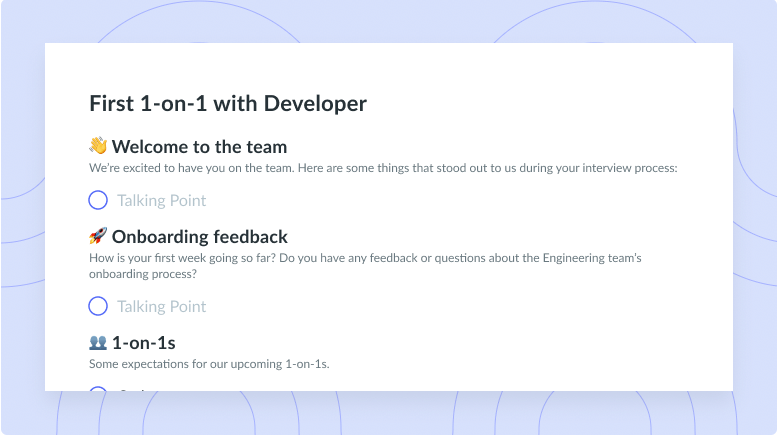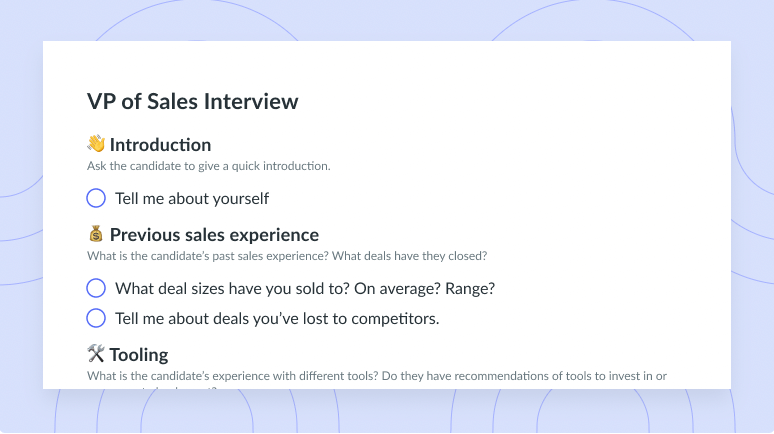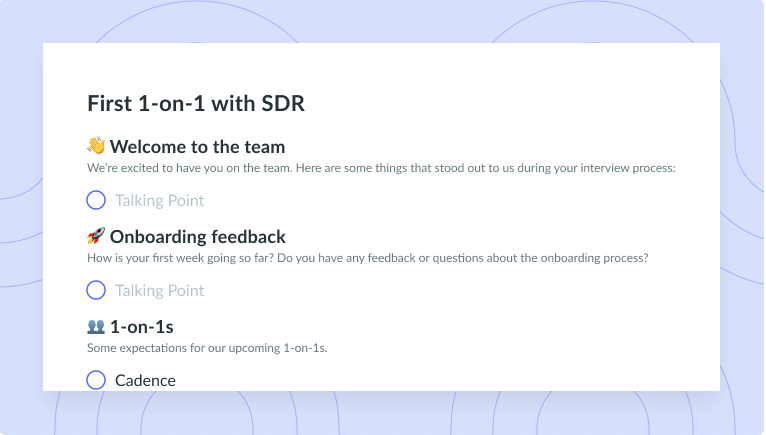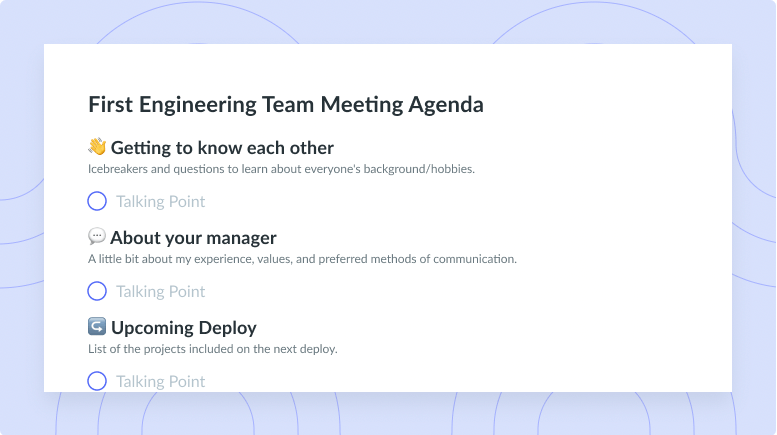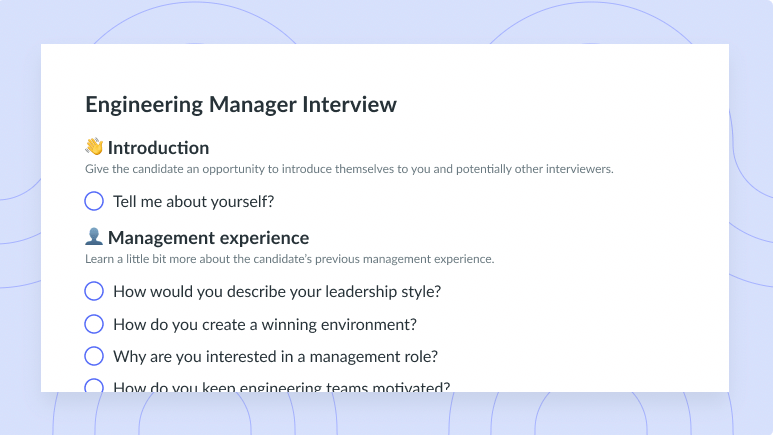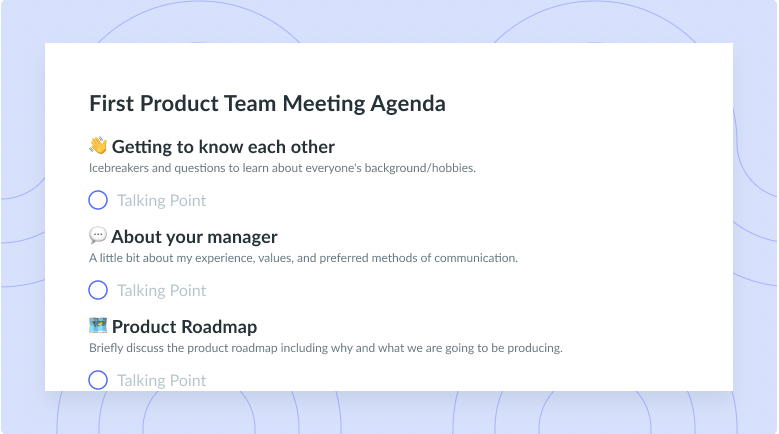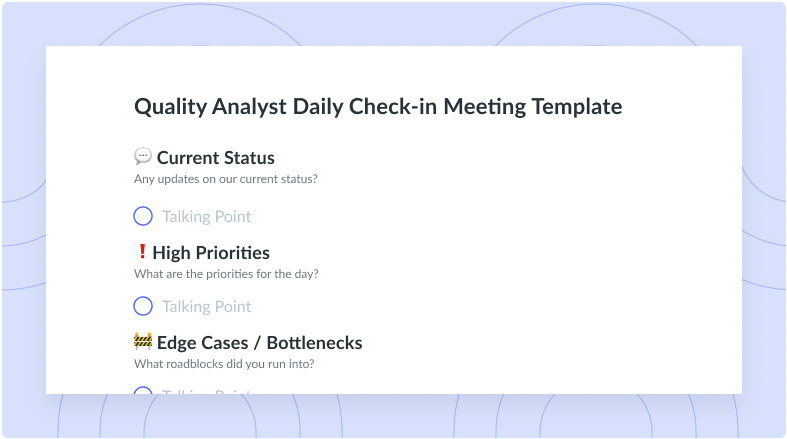Organizing Top Priorities for a New VP of Engineering
Taking over a new team? Learn about to know about the role of a VP of engineering and 12 top priorities. Plus, get free templates!
Whether you’re taking over an existing engineering team or building one from scratch, there is no doubt that there will always be big shoes to fill for any new VP of engineering. Projects and processes in the engineering world are incredibly agile, and it can be hard to stay on top of the latest trends. And if you’re taking over an existing team, you’re likely walking into a completely unique tech stack and team experience, which probably has a lot of background history for you to catch up on.
Since it can seem daunting to enter this role for the first time, we’ve put together a few insights on top priorities for a new VP of engineering to help make the first few weeks just a bit easier.
- What is the role of a VP of engineering?
- 12 top priorities for a new VP of engineering
- VP of engineering interview template
What is the role of a VP of engineering?
The VP of engineering is an executive-level leader of the engineering department. They oversee budgets and hiring decisions, and they help to strategize process optimization. As an executive engineering manager of sorts, they don’t do much tactical work. However, they do work closely with technical and project leads to help solve problems and assess team performance.

Managing a team?
Take control of your team meetings by having collaborative meeting notes and encouraging accountability with action items. Try a tool like Fellow!

12 top priorities for a new VP of engineering
- Hire new engineers
- Retain top engineering talent
- Deliver on the CTO’s engineering strategy
- Foster a psychologically safe engineering culture
- Motivate engineering employees
- Create alignment across all engineering teams
- Maintain lines of communication between all levels of engineers
- Ensure engineers produce high-quality projects
- Manage the engineering team’s budget
- Plan and implement technological developments
- Improve the engineering team’s workflow
- Schedule recurring one-on-ones with direct reports
1Hire new engineers
While this isn’t the first thing you want to do on day one of your new role, you do want to start thinking of it right from the beginning. Your engineering team will be responsible for all the new initiatives that you’ll be bringing into this department, so it’s important that you have a team that can match the skills and experience that will be required. In your first week, consider doing an audit of who is currently on the team to identify possible gaps for upcoming hiring. And you can’t hire without any budget, so make sure to loop in your manager, chief executive officer (CEO), or chief financial officer (CFO) into your plans as well.
2Retain top engineering talent
It’s common that a team will see a lot of turnover when a new executive takes over an existing team. While this is normal, you don’t want to risk losing top talent in these times of change. Identify who these best performers are as early as possible. Speak to other managers in the engineering department and have one-on-one meetings with team leads to get to know who the top talent is, and what motivators will help keep them in their roles.
3Deliver on the CTO’s engineering strategy
As the VP of engineering, you don’t have full say on everything that happens in the engineering department. You’ll need to work closely with the chief technology officer (CTO) to align to their strategy (this is likely whom you will report to as well). If you can’t meet with the CTO before you start your role, make it a priority to meet with them within the first day or two of your start date. Get clear on the objectives and key results (OKRs) that have been set out, the progress already made towards these goals, any large blockers, and the resources available to help meet these goals.
4Foster a psychologically safe engineering culture
A psychologically safe work environment is one where employees feel they can experiment and take risks with little fear of losing their jobs or being yelled at if they fail. Experimentation and educated risk-taking are vital to innovation and growth in an engineering team. You can foster the development of a psychologically safe culture by asking teams to brainstorm openly together, honouring feedback, and encouraging individuals to reflect on projects in sprint retrospectives to see how they can do better in the future. In times when your team members do fail (even catastrophically), it’s best to remain calm, be clear about expectations, and be honest in your feedback.
5Motivate engineering employees
While undervalued, motivating your employees right from the start should be a top priority for a new VP of engineering. Times of change can make employees feel confused, lose purpose, or be less confident about the future. Speak with employees in one-on-ones or ask other engineering managers which techniques best motivate the team. For some teams, a good motivator could be higher numbers of team projects to stay social and engaged. Other teams might drive motivation from competitions and gamification of project tasks (such as rewarding the person who finds the most bugs in the quality assurance process).
6Create alignment across all engineering teams
Today’s engineering teams are made up of a ton of smaller segments, such as development, quality assurance, operations, security, and network management, among others. Creating alignment across these teams can be done through engineering processes such as the adoption of DevSecOps or managerial approaches like more frequent team meetings. Some examples of engineering team meetings to host regularly include brainstorms, sprint planning meetings, and backlog grooming meetings.
7Maintain lines of communication between all levels of engineers
As developers spend a lot of their time in a niche role, it’s very easy for them to get siloed and avoid communication with members of the wider engineering team. Help engineers avoid this by opening lines of communication across the full department. The use of Slack channels or team meetings can help to mitigate or prevent this issue. Also, clearly address any communication expectations like communication frequency and style (for example, turn cameras on during video calls, be respectful in the group chats) as soon as possible.
8Ensure engineers produce high-quality projects
Getting involved in the trenches of the engineering efforts can help you gauge if the team is producing high-quality work. Spend a bit of time seeing for yourself what it’s like to work as an engineer. Do they have the resources and information they need to get the job done? If not, how can you help them?
A common area of weakness for engineering teams is lack of clear information from business teams (for example, sales and marketing). This may be a weak link in the product management department. Another common weakness is infrequent quality assurance and security testing. When developers are under high pressure to get more code deployed quickly, these are easy steps to skip over (but will come back to bite you down the road).
9Manage the engineering team’s budget
In your first week, your CTO or supervisor should inform you of the budget that you will be overseeing. It’s ideal to discuss strategic spending goals, any already committed funds, and any leeway for new hires or tooling with them. Without this information, you may find it difficult to make decisions about any other element of the engineering department.
Another vital part of the budget is ensuring you can efficiently and properly manage it. Speak with your company’s finance team about processes for submitting expenses, tracking general ledger (GL) codes, or other administrative processes.
10Plan and implement technological developments
Of course, the ultimate goal of leading a new engineering team is to help them get to the next level of success. Work with your team and leaders to create a technological development road map during your first month. While it will likely take a long time to execute all the elements of the road map, it’s helpful to start tracking your ideas while you still have a fresh perspective on the team’s operations.
If you’re unsure where to get inspiration for technological developments, take a look at any gaps or blockers in the current engineering process.
- Can anything be automated, tracked, or monitored more efficiently?
- Are there any tools that can help speed up time to production or decrease the number of bugs found in each sprint?
- What kinds of features do customers expect, and does your team have the technological capabilities in place today?
11Improve the engineering team’s workflow
In your first week or two, spend more of your time observing the team before committing to any changes. It’s ideal to see how the team naturally operates to make decisions that work best for their rhythm. For example, some things to look out for include:
- Who does everyone go to when they have a problem? Is this the right person for them to be going to?
- How frequently are teams syncing up? Is this frequency enough, or too much?
- How often is code tested for bugs? What happens when bugs are found? Is this the best approach?
- What would happen if the system experienced downtime? Does the team know how to respond?
12Schedule recurring one-on-ones with direct reports
A lot is going to happen in your first few weeks as a new VP of engineering. Taking time to meet with each of your direct reports in a one-on-one should be a top priority. Not only is this meeting a great time to get some deep insights from your team’s leaders, but it can also give you time to slow down, breathe, and build strong relationships with your reports. Scheduling these one-on-ones on a weekly, bi-weekly, or monthly basis will help you stay in tune with team members’ projects and development. Consider scheduling at a cadence that reflects the experience, complexity of work, and autonomy of each direct report.
Unsure how to lead a productive one-on-one? Use this template for insights on meeting agenda topics that will make the most out of your engineering leaders’ time.
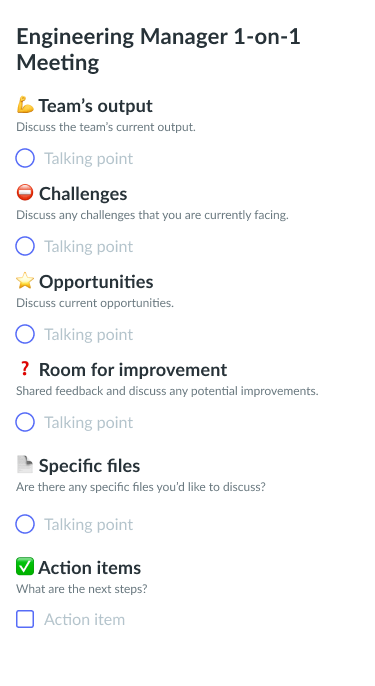
VP of engineering interview template
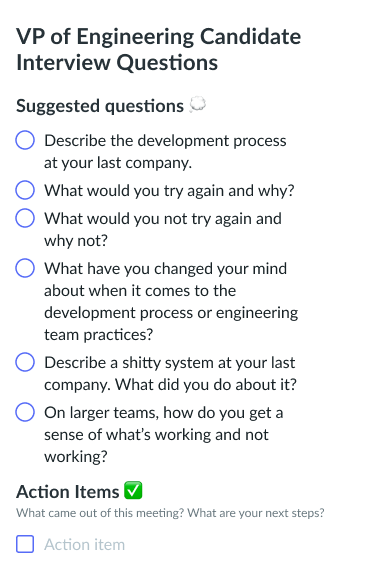
Parting advice
Joining a new team for the first time can feel daunting. It may seem like you’re the only person who doesn’t know what’s going on. Take time to ask questions, observe, and get to know your team well before jumping too far into actions and change. This will help you build the full context of the current engineering culture and processes to make the right decisions. Trust in your experience and take your time—soon enough, you’ll be on the road to leading an agile, aligned, and very productive engineering team!






![On-Call Engineering Best Practices [+ Pros & Cons]](https://fellow.app/wp-content/uploads/2022/09/On-Call-Engineering-Best-Practice.jpg)


